Family name: Apocynaceae Jussieu
Synonym(s): Asclepiadaceae Borkh., nom. cons.; Periplocaceae Schltr., nom. cons.; Plumeriaceae Horan.; Stapeliaceae Horan.; Vincaceae Vest; Willughbeiaceae J. Agardh
Common name(s): dogbane family
*Number of genera/species: 366/5,100
List of genera records in GRIN-Global
Note, fruits are usually formed from a 2-carpellate, sometimes 1-carpellate by abortion, apocarpousapocarpous:
gynoecium with two or more distinct carpels
, superiorsuperior:
ovary not enclosed to any degree by a floral tube casing, the perianth and/or androecium thus arising beneath (proximal to) it
ovary. FolliclesFollicle:
a dry to (rarely) fleshy fruit derived from a single carpel that opens along a single longitudinal suture, derived from a single, superior, simple ovary; the seeds may be arillate or with a fleshy testa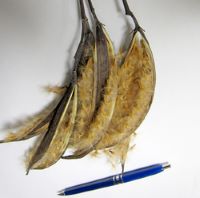 and other fruit types, berriesberry:
and other fruit types, berriesberry:
an indehiscent, fleshy fruit with one or a few to many seeds. The flesh may be homogenous throughout. Or, if the outer part is hard, firm, or leathery, referred to as an hesperidium. Septa are present in some, and the seeds may be arillate or with a fleshy testa.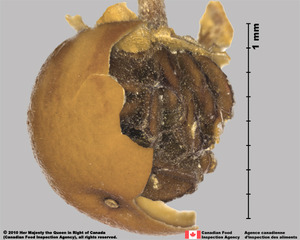 or drupesdrupe:
or drupesdrupe:
(indehiscent drupe) a fleshy, indehiscent fruit with one more hard pits enclosing seeds, derived from single, superior, simple or compound ovary; (dehiscent drupe) a fruit with a dry or fibrous to fleshy or leathery outer husk that early to tardily breaks apart (or opens), exposing one or more nutlike pits enclosing the seeds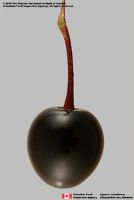 , may occur in pairs.
, may occur in pairs.
Fruit usually a folliclefollicle:
a dry to (rarely) fleshy fruit derived from a single carpel that opens along a single longitudinal suture, derived from a single, superior, simple ovary; the seeds may be arillate or with a fleshy testa , paired or solitary, a paired folliclefollicle:
, paired or solitary, a paired folliclefollicle:
a dry to (rarely) fleshy fruit derived from a single carpel that opens along a single longitudinal suture, derived from a single, superior, simple ovary; the seeds may be arillate or with a fleshy testa may fuse into a “double-follicle”, which splits at maturity along area of fusion. Or a berryberry:
may fuse into a “double-follicle”, which splits at maturity along area of fusion. Or a berryberry:
an indehiscent, fleshy fruit with one or a few to many seeds. The flesh may be homogenous throughout. Or, if the outer part is hard, firm, or leathery, referred to as an hesperidium. Septa are present in some, and the seeds may be arillate or with a fleshy testa. (bilocularbilocular:
(bilocularbilocular:
(ovary or fruit) having two locules
or unilocular, Whillughbeieae, Tabernaemontaneae, Melodineae, Hunterieae, Carisseae), drupedrupe:
(indehiscent drupe) a fleshy, indehiscent fruit with one more hard pits enclosing seeds, derived from single, superior, simple or compound ovary; (dehiscent drupe) a fruit with a dry or fibrous to fleshy or leathery outer husk that early to tardily breaks apart (or opens), exposing one or more nutlike pits enclosing the seeds (Vinceae, Plumerieae, Alyxieae–fleshy or woodywoody:
(Vinceae, Plumerieae, Alyxieae–fleshy or woodywoody:
texture—consisting mainly of indurate lignified tissues, characteristic of or resembling wood
), rarely a capsulecapsule:
a dry, dehiscent fruit derived from a compound ovary (Allamanda, Craspidospermum, Plectaneia), samaroid drupedrupe:
(Allamanda, Craspidospermum, Plectaneia), samaroid drupedrupe:
(indehiscent drupe) a fleshy, indehiscent fruit with one more hard pits enclosing seeds, derived from single, superior, simple or compound ovary; (dehiscent drupe) a fruit with a dry or fibrous to fleshy or leathery outer husk that early to tardily breaks apart (or opens), exposing one or more nutlike pits enclosing the seeds (paired, Cameraria, Ceberiopsis), or a spinyspiny:
(paired, Cameraria, Ceberiopsis), or a spinyspiny:
having slender, stiff, sharp projections oriented in the general plane of the structure nutletnutlet:
nutletnutlet:
˜achene;
(Emicocarpus). Fruits 5–610 mm long.
FolliclesFollicle:
a dry to (rarely) fleshy fruit derived from a single carpel that opens along a single longitudinal suture, derived from a single, superior, simple ovary; the seeds may be arillate or with a fleshy testa usually fusiformfusiform:
usually fusiformfusiform:
spindle-shaped; broadest at the middle and tapering at both ends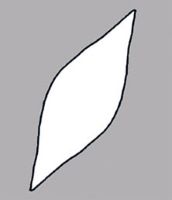 or linearlinear:
or linearlinear:
(shape) long, narrow, and uniform in width; (of embryo) embryo is straight and much longer than wide , compressedcompressed:
, compressedcompressed:
flattened; in grasses, used to denote compression (not necessarily flattened) either laterally or dorsiventrally
or tereteterete:
approximately circular in cross section; width and thickness approximately equal in transection, beakedbeak:
in transection, beakedbeak:
a usually firm, terminal appendage, sometimes tapered . Paired folliclesfollicle:
. Paired folliclesfollicle:
a dry to (rarely) fleshy fruit derived from a single carpel that opens along a single longitudinal suture, derived from a single, superior, simple ovary; the seeds may be arillate or with a fleshy testa often fused at their apicesapex:
often fused at their apicesapex:
the point farthest from the point of attachment, or the "tip" of an organ until maturation splits them apart, usually many seeded, and not enclosed by floral parts or bracts. Pericarppericarp:
until maturation splits them apart, usually many seeded, and not enclosed by floral parts or bracts. Pericarppericarp:
fruit wall or fruit coat
brown, green, white, or yellow to orange, dulldull:
reflecting only a low proportion of incident light, with no apparent sheen , usually dry, thin or thick, sometimes woodywoody:
, usually dry, thin or thick, sometimes woodywoody:
texture—consisting mainly of indurate lignified tissues, characteristic of or resembling wood
or fleshy. Pericarppericarp:
fruit wall or fruit coat
glabrousglabrous:
without hairs
or pubescentpubescent:
surface relief—bearing hairs
, usually smooth, sometimes ornamented or with wings. Seeds usually less than 40 mm long, often compressedcompressed:
flattened; in grasses, used to denote compression (not necessarily flattened) either laterally or dorsiventrally
, with comacoma:
a tuft of hairs, often attached to the tip of seeds
, beakedbeak:
a usually firm, terminal appendage, sometimes tapered , with or without winglike margin, and usually glabrousglabrous:
, with or without winglike margin, and usually glabrousglabrous:
without hairs
.
BerriesBerry:
an indehiscent, fleshy fruit with one or a few to many seeds. The flesh may be homogenous throughout. Or, if the outer part is hard, firm, or leathery, referred to as an hesperidium. Septa are present in some, and the seeds may be arillate or with a fleshy testa. and drupesdrupe:
and drupesdrupe:
(indehiscent drupe) a fleshy, indehiscent fruit with one more hard pits enclosing seeds, derived from single, superior, simple or compound ovary; (dehiscent drupe) a fruit with a dry or fibrous to fleshy or leathery outer husk that early to tardily breaks apart (or opens), exposing one or more nutlike pits enclosing the seeds , apocarpousapocarpous:
, apocarpousapocarpous:
gynoecium with two or more distinct carpels
or syncarpoussyncarpous:
gynoecium with two or more united carpels
, globoseglobose:
3D shape—more or less spherical to ellipsoidellipsoid:
to ellipsoidellipsoid:
3D shape—elliptic
, sometimes toruloseknotted:
3D shape—a cylindrical or ellipsoid body that is swollen and constricted at intervals; torulose or moniliformmoniliform:
or moniliformmoniliform:
elongate, relatively slender, transversely round, and more or less regularly constricted over its length, the whole straight or variously curved; like a necklace of beads, see torulose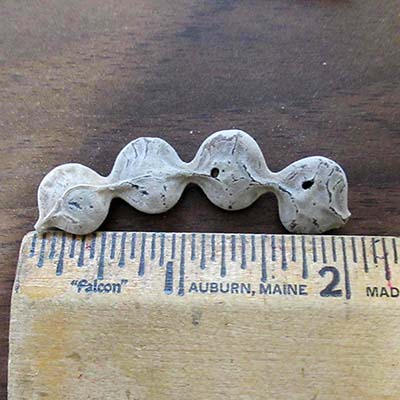 , tereteterete:
, tereteterete:
approximately circular in cross section; width and thickness approximately equal in transection. BerriesBerry:
in transection. BerriesBerry:
an indehiscent, fleshy fruit with one or a few to many seeds. The flesh may be homogenous throughout. Or, if the outer part is hard, firm, or leathery, referred to as an hesperidium. Septa are present in some, and the seeds may be arillate or with a fleshy testa. usually many seeded, sometimes one or few seeded. DrupesDrupe:
usually many seeded, sometimes one or few seeded. DrupesDrupe:
(indehiscent drupe) a fleshy, indehiscent fruit with one more hard pits enclosing seeds, derived from single, superior, simple or compound ovary; (dehiscent drupe) a fruit with a dry or fibrous to fleshy or leathery outer husk that early to tardily breaks apart (or opens), exposing one or more nutlike pits enclosing the seeds usually one seeded, sometimes two or three seeded. BerriesBerry:
usually one seeded, sometimes two or three seeded. BerriesBerry:
an indehiscent, fleshy fruit with one or a few to many seeds. The flesh may be homogenous throughout. Or, if the outer part is hard, firm, or leathery, referred to as an hesperidium. Septa are present in some, and the seeds may be arillate or with a fleshy testa. and drupesdrupe:
and drupesdrupe:
(indehiscent drupe) a fleshy, indehiscent fruit with one more hard pits enclosing seeds, derived from single, superior, simple or compound ovary; (dehiscent drupe) a fruit with a dry or fibrous to fleshy or leathery outer husk that early to tardily breaks apart (or opens), exposing one or more nutlike pits enclosing the seeds not enclosed by floral parts or bracts. Pericarppericarp:
not enclosed by floral parts or bracts. Pericarppericarp:
fruit wall or fruit coat
bright red, orange, purple, black or blue-black, usually dulldull:
reflecting only a low proportion of incident light, with no apparent sheen , sometimes shinyshiny:
, sometimes shinyshiny:
uniformly reflecting a high proportion of incident light at all angles , usually thick, fleshy, sometimes leatheryleathery:
, usually thick, fleshy, sometimes leatheryleathery:
texture—moderately thick, tough, and very pliable
or woodywoody:
texture—consisting mainly of indurate lignified tissues, characteristic of or resembling wood
. BerriesBerry:
an indehiscent, fleshy fruit with one or a few to many seeds. The flesh may be homogenous throughout. Or, if the outer part is hard, firm, or leathery, referred to as an hesperidium. Septa are present in some, and the seeds may be arillate or with a fleshy testa. often with brightly colored, pulpy, spongyspongy:
often with brightly colored, pulpy, spongyspongy:
soft, light, discontinuous but cohesive, and somewhat resilient
, or fibrousfibrous:
texture -- long, flexible threads, thicker than hairs, that densely cover and obscure the surface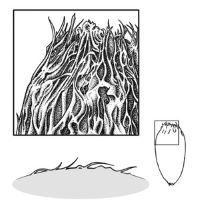 placentas. DrupesDrupe:
placentas. DrupesDrupe:
(indehiscent drupe) a fleshy, indehiscent fruit with one more hard pits enclosing seeds, derived from single, superior, simple or compound ovary; (dehiscent drupe) a fruit with a dry or fibrous to fleshy or leathery outer husk that early to tardily breaks apart (or opens), exposing one or more nutlike pits enclosing the seeds with fleshy, pulpy, or fibrousfibrous:
with fleshy, pulpy, or fibrousfibrous:
texture -- long, flexible threads, thicker than hairs, that densely cover and obscure the surface mesocarps and stony or woodywoody:
mesocarps and stony or woodywoody:
texture—consisting mainly of indurate lignified tissues, characteristic of or resembling wood
endocarps. Fruits usually glabrousglabrous:
without hairs
, usually smooth, sometimes wartywarty:
surface relief—distinct, rounded projections that are large relative to the fruit size; tuberculate, verrucose (Hunteria spp.) or with soft prickles (Tabernanthe spp.). Seeds compressedcompressed:
(Hunteria spp.) or with soft prickles (Tabernanthe spp.). Seeds compressedcompressed:
flattened; in grasses, used to denote compression (not necessarily flattened) either laterally or dorsiventrally
, usually wingless (apically winged, Thevetia, winglike margin, Cameraria, Cerberiopsis, Ochrosia), and without comacoma:
a tuft of hairs, often attached to the tip of seeds
.
CapsulesCapsule:
a dry, dehiscent fruit derived from a compound ovary occur in three genera, Allamanda, Craspidospermum, and Plectaneia. CapsulesCapsule:
occur in three genera, Allamanda, Craspidospermum, and Plectaneia. CapsulesCapsule:
a dry, dehiscent fruit derived from a compound ovary septicidal, 30–70 mm long, globoseglobose:
septicidal, 30–70 mm long, globoseglobose:
3D shape—more or less spherical , ovoidovoid:
, ovoidovoid:
3D shape—ovate , or linearlinear:
, or linearlinear:
(shape) long, narrow, and uniform in width; (of embryo) embryo is straight and much longer than wide , with many seeds. Pericarppericarp:
, with many seeds. Pericarppericarp:
fruit wall or fruit coat
brown, woodywoody:
texture—consisting mainly of indurate lignified tissues, characteristic of or resembling wood
or fleshy, glabrousglabrous:
without hairs
, smooth (Craspidospermum), spinyspiny:
having slender, stiff, sharp projections oriented in the general plane of the structure (Allamanda), or with four ribs or wings (Plectaneia). Seeds compressedcompressed:
(Allamanda), or with four ribs or wings (Plectaneia). Seeds compressedcompressed:
flattened; in grasses, used to denote compression (not necessarily flattened) either laterally or dorsiventrally
, winged, and without comacoma:
a tuft of hairs, often attached to the tip of seeds
.
Seeds usually ovoidovoid:
3D shape—ovate , flattened, compressedcompressed:
, flattened, compressedcompressed:
flattened; in grasses, used to denote compression (not necessarily flattened) either laterally or dorsiventrally
, or tereteterete:
approximately circular in cross section; width and thickness approximately equal
 in transection, 2–80 mm long, often with a tuft of brown to white hairs at the micropylarmicropyle:
in transection, 2–80 mm long, often with a tuft of brown to white hairs at the micropylarmicropyle:
an opening in the integuments of an ovule usually acting as a passage for the pollen tube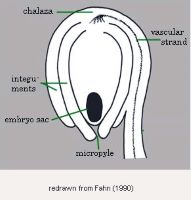 end (comacoma:
end (comacoma:
a tuft of hairs, often attached to the tip of seeds
), sometimes chalazalchalaza:
the region at the base of the ovule where the integuments are inserted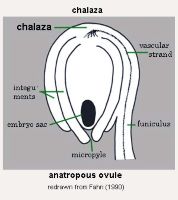 end or both ends, usually wingless. If winged, then wing paperypapery:
end or both ends, usually wingless. If winged, then wing paperypapery:
texture—papyraceous, chartaceous; very thin, pliable, and readily torn; like paper
, membranousmembranous:
texture—extremely thin, pliable, and fairly tough
, or fibrousfibrous:
texture -- long, flexible threads, thicker than hairs, that densely cover and obscure the surface , at one or both ends or around the margin. Arilaril:
, at one or both ends or around the margin. Arilaril:
(broad sense) appendicular structure that wholly or partly envelops a seed and is produced from or a modification of the funicle, raphe, or outer integument; usually fleshy or pulpy, sometimes spongy or tufted-capillate, often brightly colored present in some genera, often brightly colored and fleshy, waxy, mucilaginousmucilaginous:
present in some genera, often brightly colored and fleshy, waxy, mucilaginousmucilaginous:
resembling mucilage; moist and sticky
, or corkycorky:
firm, relatively light, discontinuous but strongly cohesive, and resilient
(Chilocarpus). Seed coat black or brown, glabrousglabrous:
without hairs
, sometimes hairy, smooth or variously sculptured.
Embryo well developed, partially filling seed, axileaxile:
on or of the axis
or centric, foliatefoliate:
appearing leaf-like
or linearlinear:
(shape) long, narrow, and uniform in width; (of embryo) embryo is straight and much longer than wide , straight, sometimes bentbent:
, straight, sometimes bentbent:
(of embryo) embryo is bent at an acute, V-shaped angle with the ends close together and generally thick cotyledons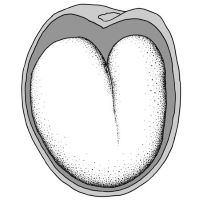 , often chlorophyllous.
, often chlorophyllous.
Endosperm absent, scanty, or copious, if present oily, in some genera ruminateruminate:
testa or seed coat folded into the endosperm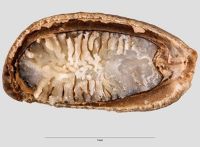 .
.
| Fruit | |
| Type | folliclefollicle: a dry to (rarely) fleshy fruit derived from a single carpel that opens along a single longitudinal suture, derived from a single, superior, simple ovary; the seeds may be arillate or with a fleshy testa  , capsulecapsule: , capsulecapsule:a dry, dehiscent fruit derived from a compound ovary  , berryberry: , berryberry:an indehiscent, fleshy fruit with one or a few to many seeds. The flesh may be homogenous throughout. Or, if the outer part is hard, firm, or leathery, referred to as an hesperidium. Septa are present in some, and the seeds may be arillate or with a fleshy testa.  , drupedrupe: , drupedrupe:(indehiscent drupe) a fleshy, indehiscent fruit with one more hard pits enclosing seeds, derived from single, superior, simple or compound ovary; (dehiscent drupe) a fruit with a dry or fibrous to fleshy or leathery outer husk that early to tardily breaks apart (or opens), exposing one or more nutlike pits enclosing the seeds  |
| Size range | 5–610 mm long |
| Shape(s) | usually fusiformfusiform: spindle-shaped; broadest at the middle and tapering at both ends  to linearlinear: to linearlinear:(shape) long, narrow, and uniform in width; (of embryo) embryo is straight and much longer than wide  , sometimes ellipsoidellipsoid: , sometimes ellipsoidellipsoid:3D shape—elliptic , oblongoblong: 2D shape—much longer than broad with nearly parallel sides, corners are rounded  , cylindriccylindrical: , cylindriccylindrical:3D shape—a cylinder, with parallel sides and a circular cross-section; tubular or rod-shaped , obclavateobclavate: 3D shape—club-shaped, with attachment at or near the broad end (compare clavate) 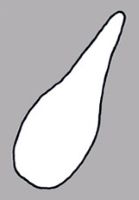 , or pear-shaped, rarely globoseglobose: , or pear-shaped, rarely globoseglobose:3D shape—more or less spherical  , toruloseknotted: , toruloseknotted:3D shape—a cylindrical or ellipsoid body that is swollen and constricted at intervals; torulose  , moniliformmoniliform: , moniliformmoniliform:elongate, relatively slender, transversely round, and more or less regularly constricted over its length, the whole straight or variously curved; like a necklace of beads, see torulose  or triangulartriangular: or triangulartriangular:2D shape—three relatively straight sides with distinct corners; more angular than teardrop-shaped  (Emicocarpus) (Emicocarpus) |
| Texture |
folliclefollicle: berryberry: drupedrupe: |
| Surface relief | usually smooth, sometimes with irregular corkycorky: firm, relatively light, discontinuous but strongly cohesive, and resilient prickles or ridgedridged: surface relief—raised, thick ridges, sharp edged or rounded, usually in a series that may cover the entire surface 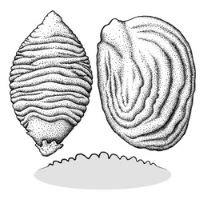 , winged, or spinyspiny: , winged, or spinyspiny:having slender, stiff, sharp projections oriented in the general plane of the structure  nutletnutlet: nutletnutlet:˜achene ) Emicocarpus) |
| Color(s) | black, blue-black, brown (all shades), red, orange, yellow, green, purple |
| Unique features | Usually fusiformfusiform: spindle-shaped; broadest at the middle and tapering at both ends  or linearlinear: or linearlinear:(shape) long, narrow, and uniform in width; (of embryo) embryo is straight and much longer than wide  , beakedbeak: , beakedbeak:a usually firm, terminal appendage, sometimes tapered  , and often paired folliclesfollicle: , and often paired folliclesfollicle:a dry to (rarely) fleshy fruit derived from a single carpel that opens along a single longitudinal suture, derived from a single, superior, simple ovary; the seeds may be arillate or with a fleshy testa  , which are often fused at their apicesapex: , which are often fused at their apicesapex:the point farthest from the point of attachment, or the "tip" of an organ  until maturation splits them apart, not enclosed by floral parts or bracts, and with numerous, compressedcompressed: until maturation splits them apart, not enclosed by floral parts or bracts, and with numerous, compressedcompressed:flattened; in grasses, used to denote compression (not necessarily flattened) either laterally or dorsiventrally , tufted-hair seeds. |
| Seed | |
| Size range | 2–80 mm long |
| Shape(s) | ovoidovoid: 3D shape—ovate  , fusiformfusiform: , fusiformfusiform:spindle-shaped; broadest at the middle and tapering at both ends  , ellipsoidellipsoid: , ellipsoidellipsoid:3D shape—elliptic , pear-shaped, globoseglobose: 3D shape—more or less spherical  , cylindricalcylindrical: , cylindricalcylindrical:3D shape—a cylinder, with parallel sides and a circular cross-section; tubular or rod-shaped , oblongoblong: 2D shape—much longer than broad with nearly parallel sides, corners are rounded  , linearlinear: , linearlinear:(shape) long, narrow, and uniform in width; (of embryo) embryo is straight and much longer than wide  , rarely plano-convexplano-convex: , rarely plano-convexplano-convex:2D or 3D shape—flat on one side, convex on the other 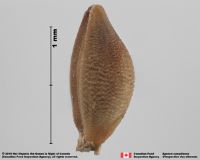 , angularangular: , angularangular:2D shape—having sides that meet at acute or obtuse angles , U-shaped (Emicocarpus) |
| Surface relief | smooth, pittedpitted: surface relief—surface with small depressions in which the areas between the hollows do not take on the appearance of a true reticular net  , ridgedridged: , ridgedridged:surface relief—raised, thick ridges, sharp edged or rounded, usually in a series that may cover the entire surface  , groovedgrooved: , groovedgrooved:surface relief—linear depressions that may be single or form a series of grooves over the surface 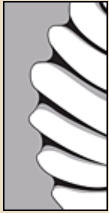 , wartywarty: , wartywarty:surface relief—distinct, rounded projections that are large relative to the fruit size; tuberculate, verrucose  , papillosepapillate: , papillosepapillate:surface relief—bearing minute, distinct, broad-based projections, tapering to a rounded apex  , tuberculatetuberculate: , tuberculatetuberculate:surface relief—bearing small, warty, swelling, rounded, or variously shaped projections 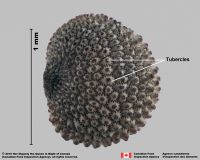 , crenulatecrenulate: , crenulatecrenulate:finely crenate (scalloped) |
| Color(s) | brown, black |
| Unique features | Seeds usually less than 40 mm long, often compressedcompressed: flattened; in grasses, used to denote compression (not necessarily flattened) either laterally or dorsiventrally , with a comacoma: a tuft of hairs, often attached to the tip of seeds , beakedbeak: a usually firm, terminal appendage, sometimes tapered  , with or without winglike margin, and usually glabrousglabrous: , with or without winglike margin, and usually glabrousglabrous:without hairs . If comacoma: a tuft of hairs, often attached to the tip of seeds lost, a light, triangulartriangular: 2D shape—three relatively straight sides with distinct corners; more angular than teardrop-shaped  or lens-shapedlens-shaped: or lens-shapedlens-shaped:2D shape—round and flattened with two curved (convex) surfaces scar remains. |
| Other | |
| Embryo | well developed, partially filling seed, axileaxile: on or of the axis or centric, foliatefoliate: appearing leaf-like or linearlinear: (shape) long, narrow, and uniform in width; (of embryo) embryo is straight and much longer than wide  , straight, sometimes bentbent: , straight, sometimes bentbent:(of embryo) embryo is bent at an acute, V-shaped angle with the ends close together and generally thick cotyledons  , often chlorophyllous , often chlorophyllous |
| Nutritive tissue | endosperm absent, scanty, or copious, if present oily, ruminateruminate: testa or seed coat folded into the endosperm  in some genera in some genera |
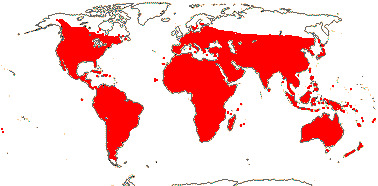
Distribution map courtesy of Angiosperm Phylogeny Website.
Endress and Bruyns 2000Endress and Bruyns 2000:
Endress ME and Bruyns PV. 2000. A revised classification of the Apocynaceae s.l. Botanical Review 66: 1–56. https://doi.org/10.1007/BF02857781; Flora of North America Editorial Committee 1993+Flora of North America Editorial Committee 1993+:
Flora of North America Editorial Committee, eds. 1993+. Flora of North America North of Mexico [Online]. 22+ vols. Flora of North America Association, New York and Oxford. Accessed January-March 2024. URL: http://beta.floranorthamerica.org.; Kirkbride et al. 2006Kirkbride et al. 2006:
Kirkbride JH, Jr, Gunn CR, and Dallwitz MJ. 2006. Family guide for fruits and seeds, vers. 1.0. Accessed September 2020-January 2022. URL: https://nt.ars-grin.gov/seedsfruits/keys/frsdfam/index.cfm .; Kubitzki et al. 1990+Kubitzki et al. 1990+:
Kubitzki K et al., eds. 1990+. The families and genera of vascular plants. 7+ vols. Berlin etc.; USDA 1980USDA 1980:
United States Dept. of Agriculture (USDA). 1980. Major weed family identification guide. Hyattsville Md, United States ; Zhengyi et al. 2004+Zhengyi et al. 2004+:
Zhengyi W, Raven PH, and Deyuan H. 2004+. Flora of China [online]. 25 vols. Science Press, Beijing China & Missouri Botanical Garden, St. Louis USA. Accessed January–March 2024. http://flora.huh.harvard.edu/china/
*The number of genera and species is based on Christenhusz and Byng 2016Christenhusz and Byng 2016:
Christenhusz MJM and Byng JW. 2016. The number of known plant species in the world and its annual increase. Phytotaxa 261 (3): 201-217. https://doi.org/10.11646/phytotaxa.261.3.1, which may differ from the number of genera in GRIN-Global.